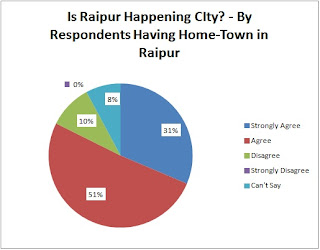BACKGROUND:
Background to the Survey is
given in the following blog-post:-
SURVEY DESIGN:
Document on the Design of
the Survey can be accessed at following link:-
SURVEY RESULTS
In
the survey, professionals from the state working at different locations across
the globe were asked to make choice on following questions:-
Question-1:
With good institutes getting operational (like IIM, IIIT, AIIMS, HNLU),
improved health care facilities, improving recreational facilities (Malls and
Multiplexes, Open-Air Museum, Stadiums), enhanced connectivity, availability of
residential societies with best amenities and with attitudinal support for
multicultural harmony, do you think that now Raipur is one of the happening
places?
To
select answers from following choices:-
a.
Strongly Agree
b.
Agree
c.
Disagree
d.
Strongly
Disagree
e.
Can't Say
Question-2:
Would you like to relocate to Raipur, if you are offered the same job profile
with same pay package and same career development path by your company (or any
other company at par with the company you work for)?
To
select answers from following choices:-
a.
Surely
b.
May be
c.
May be after a
few years
d.
No
e.
Never
f.
Can't Say
In reference to Question-1
and Question-2 above, the key results of the survey are summarized in the
following paragraphs.
Professionals
having their home towns in the state of Chhattisgarh have shown a strong
inclination in favor of relocating to work in the state. In the survey,
approximately three fourth (74.3%) of the respondents have indicated that they
would ‘Surely’ like to return to Chhattisgarh.
Further,
32.4% of the respondents ‘Strongly Agree’ and 47.1% respondents ‘Agree’ that
Raipur (Capital City of Chhattisgarh) is now amongst the happening places in
India. Among these respondents (who either ‘Strongly Agree’ or ‘Agree’ that
Raipur is a happening place), 83.8% have indicated that they will like to
relocate to Raipur and only 2.5 percent have indicated that they would not like
to relocate to Raipur.
Interestingly,
approximately half of the respondents (46.7%) who did not agree (opted for ‘Strongly
Disagree’, ‘Disagree’ or ‘Can’t Say’) with the fact that Raipur is now a
happening place, have also indicated that they would ‘Surely’ like to relocate
to Raipur, if offered job prospect at par with their current job. However, one
fifth (20%) of such respondents indicated that they would not like to relocate
to Raipur.
78.8%
of respondents in the age group of 20-29 years have marked ‘Surely’ against
65.7% of respondents in the age group of 30-49 years, while answering for the
question on relocation to Raipur. Further, for the same question, 78.8% of
males were sure (marked ‘Surely’) as against 60% females (who marked ‘Surely’).
On the contrary, in the response to question on Raipur being a happening place,
respondents were more or less consistent across age-group and gender (with
percentage of respondents answering ‘Strongly Agree’ lying in the range of
thirties, while those answering ‘Agree’ lying in the range of forties).
On
the question of relocation, 66.7% of married respondents answered ‘Surely’ as
against 83.7% of the respondent having marital status as Not Married (Never
Married, Separated, Divorced and Widowed). Similarly, among the respondents
having no kids, 76.3% responded to the question (on relocation) with answer choice
of ‘Surely’ against 65.2% of those having kids. Further, amongst those respondents
who have kids, the group of respondents having eldest kid in age-range 0-5 were
more open to relocation (78.6% have indicated ‘Surely’ through answer choices
for question on relocation) in comparison with the group of respondents having
eldest kid in age-range >5 years (only 44.4% have indicated ‘Surely’ through
answer choices for question on relocation).
77%
of respondents working in services sector opted for ‘Surely’ as answer to
question on relocation, while 71% from other sectors (other than services
sector) have responded the same question with ‘Surely’. On question related to
Raipur being a happening place, around 80% in both these categories have either
chosen ‘Strongly Agree’ or chosen ‘Agree’.
Marginal
differences were observed with respect to locations as well, as (in response to
question on relocation to Raipur) 64% of respondents working abroad indicated
‘Surely’ against 77% respondents working in India. Similarly, 78% of the
respondents, who hail from Raipur showed their eagerness to come home by
selecting ‘Surely’ for question on relocation to Raipur and 71% of those
respondents who have their home towns located in cities other than Raipur have
selected ‘Surely’ for the same question.
On
taking a conservative approach, the ratio of the
respondents who agreed to Raipur being a happening place to those who disagreed
for the same has been found to be 3.69 (amongst all the respondents). In this ratio calculation extreme
answer choices (‘Strongly Agree’ and ‘Strongly Disagree’) and indecisive answer
choice (‘Can’t Say’) have not been considered.
More
details on the results of the survey are available at following links:-
RESPONDENT DISTRIBUTION
(Important Graphs on Respondents Distribution are listed below the blog for your reference)
More details on Respondents Distribution can be accessed at following link:-SURVEY RESULTS
(Important Graphs on Survey Results are listed below the blog for your reference)
More details on Survey Results can be accessed at following links:-
DETAILED-RESULTS–SURVEY–1: IS CHHATTISGARH READY TO BRING HOME PROFESSIONALS WORKING AWAY?
TABULAR-RESULTS–SURVEY–1: IS CHHATTISGARH READY TO BRING HOME PROFESSIONALS WORKINGAWAY?
SURVEY TEAM:
Santosh Behar Abhijit Chakravarty
Neha Behar Abhishek Agrawal
- - - - - - - - - - - - - - - - - - - -
RESPONDENT DISTRIBUTION
(CLICK AT IMAGES TO ENLARGE AND VIEW AS SLIDES)
KEY SURVEY RESULTS
(CLICK AT IMAGES TO ENLARGE AND VIEW AS SLIDES)
OVER ALL RESPONDENTS
OTHER IMPORTANT RESULTS
/*******************************************/






















